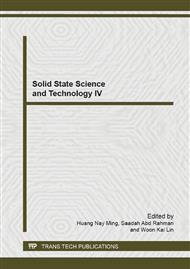p.194
p.200
p.204
p.211
p.216
p.221
p.226
p.231
p.236
Dielectric Properties of ZrO2 Doped on NiO at High Frequency
Abstract:
ZrxNi1-xO was prepared by conventional solid state reaction. The properties of undoped and ZrO2 doped NiO ceramics have been studied. The raw mixture of ZrO2 and NiO were ball milled for 24 hours. The samples were calcined at 1000°C for 2 hours, pressed into pellet shape at 200 MPa and sintered at 1300°C for 10 hours. The sintered samples were subjected to XRD, Scanning Electron Microscopy (SEM) and Impedance Analyzer for phase identification, microstructural observation and dielectric analysis. The grains size decrease with the increment of dopant amount. Enhanced dielectric constant was observed in the ZrO2 doped NiO with x= 0.02 for the frequency range from 1MHz to 1GHz. The dielectric constant of sintered ZrxNi1-xO decreased with an increasing frequency. The result indicates that Zr ions have effectively changed the dielectric properties of NiO.Keywords: NiO, Zr-doped, XRD, SEM, Dielectric.
Info:
Periodical:
Pages:
216-220
Citation:
Online since:
February 2014
Keywords:
Price:
Сopyright:
© 2014 Trans Tech Publications Ltd. All Rights Reserved
Share:
Citation:


